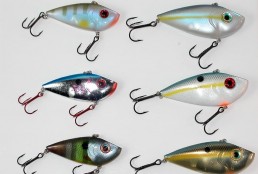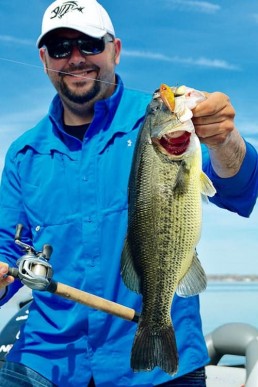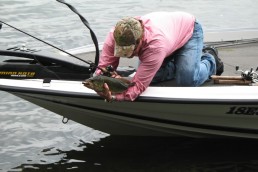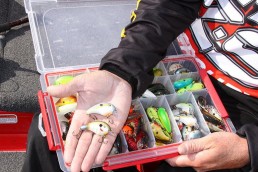Lipless Rattlers
SHARE THIS POST
Red Eye Shad does something I believe that not all other lipless rattle baits may do. No, it’s not the color schemes or the particular kind of rattle it makes. It’s different in the way that it falls, and that needs to be emphasized when throwing lipless rattlers in the cold water of April.
Here’s why the fall is important: Lures that fall like a stunned baitfish—wiggling, shimmering or shaking—naturally get eaten because that’s what bass do. Nothing against the original Rat-L-Traps and the many knock-offs that have flat sides and a flat bottom—they’re fish-catchers, too. But they just don’t have that same fall when you kill the retrieve. They kind of spiral downward and get the bites. And, sometimes more bites than a Red Eye Shad. But overall, the quivering manner with which a Red Eye Shad falls is so enticing that I wouldn’t be surprised to see an alley cat jump into the water after one.
I’m not saying the Red Eye Shad is unique to this; I’m certain that other lipless rattlers have a similar fall. In fact, some friends of mine swear by the Rapala Rippin’ Rap for the way it seductively sinks. I personally haven’t experimented with other brands.
But back to why the fall is important: In cold water, these lures can shine the brightest in April.
Many anglers think of a lipless rattler as a chunk-and-wind kind of no-brainer bait. You take a long cast and just retrieve it back at a steady pace. That approach catches fish for sure, which is why most guys and gals have at least a few lipless lures in their tackle arsenals. Wind a tightly wiggling, rattling lure that looks like a baitfish into the strike zone and a lot of times bass will eat it, even in cold water. The thing is though, in cold water, the strike zone is smaller—most times the bass just don’t have the spunk to go chase a lure that’s far away, especially one cruising along at a consistent speed, making no evasive maneuvers. But take that same lure, make that same long cast and greatly vary your retrieve, and I’m convinced you can bring bass closer.
Take your long cast around some green weeds in cold water and really fish that lure. Start by letting it sink close to where you think bottom is, and start reeling just fast enough that you can feel the lure vibrating and not sinking any farther. Now make three fast reel-handle cranks. Stop reeling altogether for a second. Start slow-rolling again, like you would while keeping a spinnerbait right along the bottom. Give the lure a few twitches. Stop; twitch, twitch. Now point your rod directly away to the left so the lure changes direction. Swing your rod all the way to the right so it changes direction again. Get creative. Next, cast until you feel the lure run into a big weed stalk. Let it stay fouled on the weed and just shake the lure. Now rip it free. A strike can come at any moment, so hopefully you were paying attention to exactly what that lure was doing when the fish bit. Try the same sequence in your next few casts and see if another bass will strike when the lure makes the same action.
The best bass anglers I know always monitor what they’re doing closely, and that’s real key any time of year. In the spring, you might as well crank up your focus, so it becomes second nature the rest of the year.
Whatever retrieve you end up using to get strikes, odds are a lot of hits will come as the lure falls, and that’s worth talking about a little bit more.
For whatever reason, bass just can’t ignore something bite-sized and that looks like food when it falls through the water column. Possibly, the gamefish see a lot of bait dive toward cover to escape getting eaten, and your lure heading toward the bottom pushes the strike button of the bass—it’s now or never if he doesn’t want that meal to get away. I think that’s especially true with fast-falling lures like a Red Eye shad, especially around weeds that offer some potential for a baitfish’s escape.
Are you enjoying this post?
You can be among the first to get the latest info on where to go, what to use and how to use it!
Exactly how you let that Red Eye fall is important, too. You really want it to fall vertically, and that means on a slack line. If you keep contact with the lure so you actually can feel it as you let it fall, you’ll be letting the lure glide toward you and not fall straight toward the bottom. This usually is not as effective as letting them fall straight down. Sure—bass being bass—that glide might get more strikes than a slack line fall. But usually, letting the lure fall on a slack line is a bazillion times more effective.
In April, throughout most of the Midwest, bass are coming up and feeding as well as starting to check out spawning areas. Perfect places to find bass are large flats with deep-water access nearby and pods of weeds up on top. Because lipless rattlers are heavy and compact, you can cast them like a bullet and a long way. And you can use them to cover a lot of water now
Red Eye Shads come in 1/4-, 1/2- and 3/4-ounce sizes and I generally only throw the bigger two sizes in spring. Much of the forage a bass eats has survived a whole year, and it’s bigger, so the bigger lures better match the hatch on most waters. The other reason is the bigger baits fly farther when I wind up and let the bait caster rip, and I want to cover a lot of water on each cast.
A 7-foot 6-inch bait-casting rod maximizes long casts, and I like one with an even, parabolic bend. I feel like a flexible rod helps keep fish hooked when they jump and try and shake the lure out of their mouths. These dense, heavy lures are pretty easy for a bass to throw, so the parabolic bend keeps just the right amount of pressure on the fish.
The bait cast reel I use has a 6.3:1 retrieve ratio, which is about medium speed. I don’t want a super-fast retrieve because I usually don’t want to burn the lure back too fast. Another key is 12-pound-test, non-stretchy fluorocarbon line. Because it has less stretch than monofilament, I can feel the lure working as soon as I start reeling, even if it’s a good ways away. Also, the low stretch of the line helps get the hooks home when the fish bites—I get a good hook-set.
As for color: the more natural, the better, especially in spring in the Midwest. Guys in Texas use those Rayburn Red Crayfish colors and certainly catch fish, but I like colors that bass are more likely to see. Sexy Shad, Sexy Blueback Herring, Gold Sexy Shad and natural-looking bluegill and sunfish patterns are all good.
So this spring, spend some time tossing a lipless rattler as soon as the water hits about 45 degrees. And instead of simply chunking and winding, get creative on the retrieve and pay special attention when you let the lure fall. Lots of times you’ll start reeling again and feel a nice-sized bass pulling back.
(Note: Buck Mallory is not sponsored by Strike King. Mallory references
Red Eye Shad lipless rattler in this article because it is the no-lip crankbait he has always thrown.)
Tournament angler and avid outdoorsman Buck Mallory of Lawton, Mich. is a regular contributor to MidWest Outdoors, specializing in bass fishing.
MWO
SHARE THIS POST
You may also like...
0 CommentsGreat Shallow-water Bass Action Right Now
Did you enjoy this post?
You can be among the first to get the latest info on where to go, what to use and how to use it!
Buck Mallory
Tournament angler and avid outdoorsman Buck Mallory of Lawton writes Michigan-specific bass fishing articles for MidWest Outdoors.



